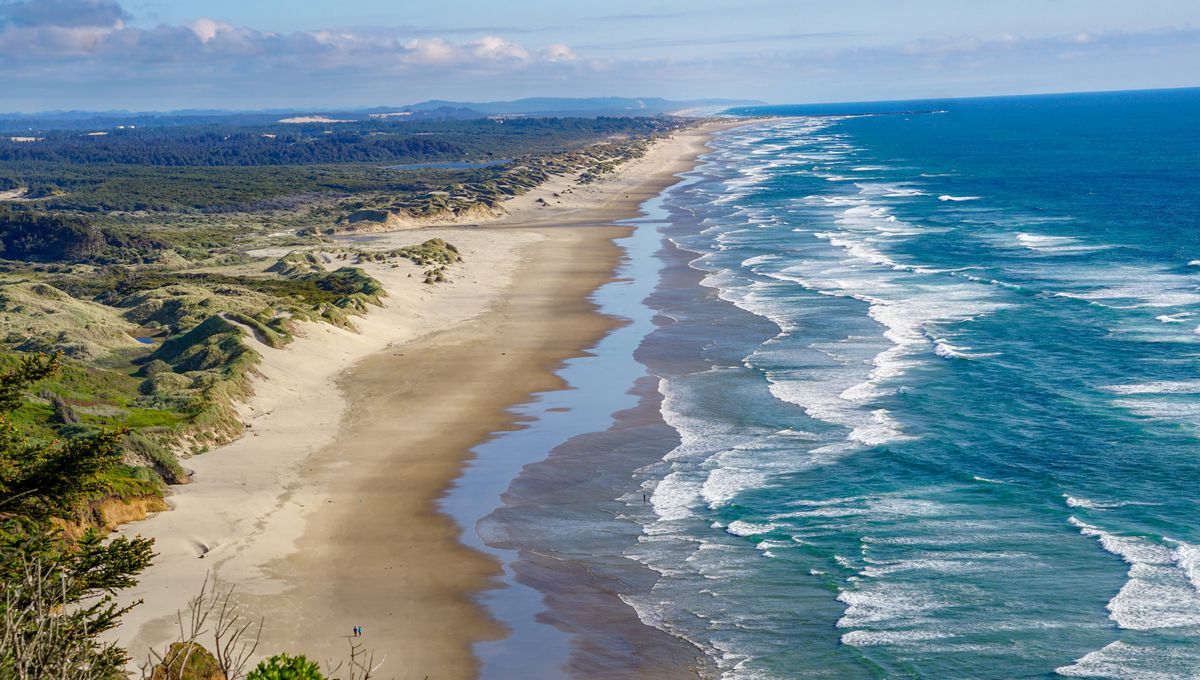
There is a sleeping giant off the coast of the Pacific Northwest that could cause chaos to North America when it eventually wakes up.
Known as the Cascadia Subduction Zone, this 1,130-kilometer-long (700-mile-long) fault line extends from around Cape Mendocino in California up to near Vancouver Island, Canada. Although it has been quiet for centuries, scientists are well aware that when it finally ruptures it will produce an enormous earthquake that could create tsunamis that reach up to 30 meters (100 feet) in height. However, new analysis suggests this would only be the start.
According to new research led by scientists at Virginia Tech, when the Cascadia Subduction Zone eventually ruptures it will cause the coast to drop by more than 1.9 meters (6.5 feet) in minutes, leading to a rapid sea level rise that would significantly impact coastal communities, dense cities, and the environment.
This would effectively extend the federally designated 1 percent coastal floodplain by 13.5 to 44.8 square kilometers (35 to 116 square miles). This could have significant long-term implications as the area already has a 1-in-100 chance of flooding each year.
“The expansion of the coastal floodplain following a Cascadia subduction zone earthquake has not been previously quantified, and the impacts to land use could significantly increase the timeline to recovery,” Tina Dura, assistant professor of geosciences in the College of Science, explained in a statement.
The Cascadia Subduction Zone is a major geological fault line that stretches through northern California, through Oregon and Washington, up to southern British Columbia. It’s a site of massive tectonic collisions. Subduction zones form where one tectonic plate is effectively being forced under another. In this instance, the Juan de Fuca Plate – a smaller oceanic plate – is being pushed underneath the larger North American Plate. This process builds up significant pressure the longer it goes on and will eventually result in a release in the form of a mega-earthquake.
The subduction zone is capable of creating quakes of magnitude 9.0 or higher, the most destructive quakes on Earth. It has now been over 300 years since Cascadia last stirred, but when this happened on January 27, 1700, it produced an 8.7 to 9.2 quake that sent a huge “orphan tsunami” across the Pacific Ocean to Japan where it was recorded in historical documents.
Cascadia is now overdue another release. According to the new study, there is now a 15 percent chance of an earthquake exceeding magnitude 8.0 along the fault in the next 50 years. But while the tsunamis this event would produce would be devastating in their own right, the long-term effects will make recovery even harder.
To determine this, Dura and colleagues generated tens of thousands of earthquake models to assess the potential range of earthquake-driven land sinkage caused by the next Cascadia quake. They then used geospatial analysis to quantify the earthquake-driven expansion of the 1 percent floodplain at 24 estuaries and communities along the subduction zone.
Given the uncertainties surround when the next quake will be, the team also modeled its impacts between today and the year 2100, a time when global sea levels will have already been significantly impacted by climate change. They found that, if the quake occurred today, it would cause an additional 14,350 residents, 22,500 structures, and 777 miles of roadway to fall within the post-earthquake floodplain. Schools, homes, hospitals, police stations, and fire stations would all be exposed to flooding, alongside eight wastewater treatment plants, an electric substation and 57 potential contaminant sources – e.g. gas stations, solid waste facilities and animal feeding operations.
If the quake occurred in 2100, then the sea level rise caused by Cascadia could be 1 meter (3 feet) higher due to the projected global sea level rise caused by climate change. This will effectively amplify the impacts of the quake, more than tripling flood exposure.
“Today, and more so in 2100 as background sea levels rise, the immediate effect of earthquake-driven subsidence will be a delay in response and recovery from the earthquake due to compromised assets. Long-term effects could render many coastal communities uninhabitable,” Dura added.
In addition to impacts on homes and important infrastructure, the extended floodplain will lead to over-salinization of soils, rendering them unusable for cattle grazing. This will also erode the natural systems of protective dunes and beaches that act as buffers against storm surges by dissipating wave energy. The resulting ecosystem loss may not be recoverable.
“The loss of intertidal wetlands directly impacts ecosystem services such as water filtration, habitat for fisheries and shorebirds, and carbon storage capacity,” Dura explained. “Intertidal wetlands function as natural carbon sinks, and their erosion or conversion to tidal flats significantly reduces their ability to sequester carbon.”
Ultimately, Dura and colleagues demonstrate how significant the next Cascadia quake will be and why preparations are needed to help mitigate its impacts.
“Cascadia is a unique place. It’s not super heavily populated, but most estuaries have a community in them, and they’re all right in the zone of subsidence,” Dura concluded. “This is honestly where I think the subsidence could have bigger impacts than it has during other recent large earthquakes around the world.”
The paper is published in PNAS.
Source Link: Next Megatsunami May Sink Parts Of The Pacific Northwest Coast By Up To 2 Meters